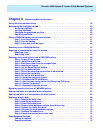
Introduction to Disk Mirroring CentreVu CMS Release 3 Version 8 Disk-Mirrored Systems
Disk mirroring defined 3
The total capacity of this concatenated metadevice is the combined
capacities of the three drives. If each drive is 4 gigabytes, for example,
the metadevice has an overall capacity of 12 gigabytes.
State databases 1
The
Solstice DiskSuite
software tracks which disk partitions belong to
which metadevices with a state database. A state database stores
information on disk about the state of your
Solstice DiskSuite
configuration.
The state database consists of multiple copies of the basic database. The
copies, referred to as state database replicas, ensure that the data in
the database is always valid. Having multiple copies protects against
data loss from single points-of-failure. The state database tracks the
location and status of all state database replicas.
Solstice DiskSuite
cannot operate until you have created the state database and its replicas:
the software must have an operating state database.
Mirrors 1
A mirror is a metadevice that can copy data from one metadevice to
another. The metadevices containing the data are called submirrors.
The process of copying the data between submirrors is called mirroring.
Mirroring provides redundant copies of data. To a software application, a
mirror looks just like a physical disk. The mirror accepts I/O requests and
converts them into I/O requests for the submirrors. The submirrors in
turn—being metadevices themselves—convert I/O requests from the
mirror into I/O requests for the underlying physical disks.
A mirror can be two-way or three-way. A two-way mirror is a mirror with
two submirrors; a three-way mirror has three submirrors. CMS supports
only two-way mirrors. The illustration below shows a typical two-way
mirror, d21, consisting of the submirrors d19 and d20.


















